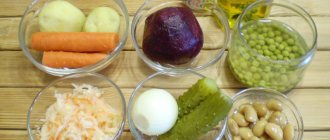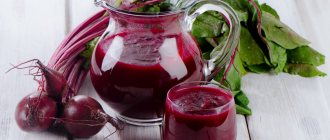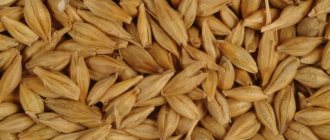Diet plays an important role in the treatment of gastric ailments. The diet should be based on exclusively healthy foods and dishes that have a positive effect on the functioning of the digestive system. Nutritionists recommend giving preference to soups made from vegetables, fruits and various cereals. The soup will be good for the stomach if you follow the correct preparation technology.
How to eat properly with gastritis
For diseases of the digestive system, there are nutritional rules, the implementation of which alleviates the condition.
- You need to eat small portions 5 times a day. It is difficult for a sick stomach to digest large amounts of food.
- It is advisable that the food be prepared as a puree. It is necessary to chew food thoroughly so as not to damage the inflamed walls of the stomach.
- Food is provided warm or at room temperature. Cold and hot foods will negatively affect the condition of the stomach, exacerbating the disease.
- Spicy, salty, smoked foods, homemade snacks and store-bought canned food are excluded.
Recommendations for preparing first courses
Soups for gastritis should be present in the diet daily. The broth gently envelops the inflamed walls of the stomach and stimulates the production of gastric secretions.
Diet soup for gastritis is prepared according to the following rules:
- The broth should not be rich. It is diluted or drained. The second is even preferable. During cooking, harmful substances contained in meat are released, which negatively affect the stomach. It is better to cook soups in the second or third broth.
- The meat is lean. You cannot cook soup on bones. Lean beef, rabbit, chicken or turkey, and low-fat fish are suitable.
- You should not overcook vegetables, avoiding loss of vitamins. Apart from satiation, such food does not bring any benefit. Vitamins are necessary to restore the body.
- Avoid seasonings and spices.
- Frying in soups is not recommended.
First course recipes
We offer the most popular and affordable recipes for dietary soups. Please note that vegetable soups are also appropriate for gastritis. We have made a selection of healthy and light soups that are appropriate for gastritis.
Rice milk
We offer a simple recipe for delicious milk soup. It will satiate you and soothe your inflamed stomach. Many people like its delicate taste. You will love this rice soup.
- Veal or lean beef (boiled) – 100 g.
- Vegetable broth - one and a half glasses.
- Milk (low-fat) – ½ cup.
- White rice (boiled) - a glass.
- Yolk – 1.
Wipe the rice. We make puree from the meat. You can grind it with a blender. Combine meat with rice. Pour in milk and broth, bring to a boil over low heat. If foam appears, skim it off. When it boils, turn off the gas. The dish should sit under a closed lid. You can use oil for refueling.
Recommended first courses
The listed soups are allowed for diseases of the digestive system.
- Puree soup for gastritis is recommended. The delicate consistency envelops the stomach and soothes inflammation. No excess energy is wasted on breaking down pieces.
- Chicken soup. Normalizes the acidity of gastric secretion. Soup is acceptable during a relapse. The skin is removed from the meat. To keep the broth low-fat, it is better to cook it with white meat. Chicken can be replaced with turkey. If desired, add noodles or dumplings, carrots, and herbs to the chicken soup. A dish is served with a boiled egg and crackers.
- Meatball soup is good for gastritis. Meat in this form does not injure the walls of the stomach and is quickly digested. It is advisable to boil the meatballs separately or steam them, then add them to the prepared vegetable soup.
- Milk soup. It is not recommended to consume milk in its pure form for gastritis. But milk soup is allowed for gastritis without exacerbation. Low-fat milk is used; it is recommended to dilute the soup with water during cooking. You can add vegetables, dumplings and cereals to this soup.
First courses for different types of gastritis
Gastritis has a broad classification, but to determine the diet it is important to distinguish two types.
- Hyperacid gastritis. With this disease, the level of acidity is increased. You need to be careful about the products you eat. Potatoes, carrots, beets, and zucchini are allowed. Sauerkraut cabbage soup, pickle soup and other sour dishes are prohibited. Pea soup is not recommended for gastritis; during remission, puree soup from young green peas is allowed. The dish contains a lot of vitamins and nutrients.
- Hypoacid gastritis. A type of gastritis characterized by low acidity of gastric secretion. In case of hypoacid type of disease, stimulation of gastric juice production is important. Eating should be measured. You need to chew your food thoroughly. Unlike hyperacid gastritis, it is allowed to prepare soups using rich meat or fish broths. Pickle soup or cabbage soup are allowed.
- For any type of gastritis, exclude gas-forming foods, including white and cauliflower, broccoli, raw onions, radishes, and legumes. Mushrooms are prohibited.
First courses during an exacerbation
It is recommended to fast for the first day. You need to drink plenty: warm or cool tea, mineral water, after releasing the gas, clean water. On the second day, jelly, potato broth, chicken broth, and slimy soup are allowed.
Patients with gastritis, especially in chronic form, need to know how mucus soup is prepared. The dish has minimal impact on the stomach mechanically and is gentle on chemical properties. Any cereal is suitable for cooking, except semolina, millet and rolled oats.
Rice cereal is used more often, as it has a beneficial effect on the stomach. It is washed and cooked over moderate heat until completely boiled. The liquid is filtered. There is no need to grind the cereal. After straining, a mucous decoction is obtained, which is brought to a boil. Boil the milk separately and add a raw egg. Mix thoroughly and combine the mixture with the mucous decoction. It is possible to add salt, but it is better not to overuse it. After recovery, it is permissible to replace the milk with vegetable or meat broth and add vegetables.
How to use?
In addition to lean borscht, there are many other types of first courses that gastroenterologists allow patients to eat. These are vegetable and vegetarian borscht, cabbage soup, with nettle and sorrel. But not everyone can eat these borschts; here one should take into account the acidity of the stomach, at what stage the disease is progressing or is in a period of chronicity with weakening symptoms (remission). In any case, you should consult your doctor before consuming this dish. Based on the patient’s health and tests, he will recommend a specific option, which will exclude those components that can harm the diseased organ.
Let us highlight the main points that should be taken into account when preparing borscht for a patient suffering from gastritis:
- borscht should not be eaten too hot or cold;
- do not put acidic foods in it that stimulate excessive production of gastric juice;
- the dish should not contain tomato paste;
- borscht should be lean;
- Do not fry, vegetables can only be lightly stewed.
Useful recipes for gastritis
- Pumpkin puree soup. Prepared in meat or vegetable broth. The main ingredient is pumpkin; carrots and potatoes are added to the dish. Vegetables are boiled until tender and chopped with a blender. To give a more delicate taste, it is permissible to add milk and bring to a boil, add salt. Pumpkin oil is used for dressing, which gives the dish a piquant taste. This component is also good for the stomach. It is important to remember that cold pressed oil should not be heated, so add it just before serving.
- Classic borscht. The dish is prepared in beef broth, but for gastritis it is recommended to use lean meat or poultry. A lean piece of meat is placed in water and brought to a boil. The first broth is drained and the meat is cooked until tender. Beets for borscht are boiled separately. Potatoes, carrots, and onions are boiled in the broth. Beets are added to the finished dish.
- Buckwheat soup with rabbit. Boil rabbit meat for 1 hour. Add potatoes, carrots, then washed buckwheat to the broth and cook until tender. At the end, season the dish with herbs.
- Milk soup with vegetables. Boil carrots and potatoes until tender. The broth is drained. Pour milk over the prepared vegetables, which should preferably be diluted with water or vegetable broth. Add some salt and bring to a boil. If desired, add fresh green peas.
- Ear. Take lean fish, for example, hake. Boil, separate the pulp from the bones. Add potatoes and carrots to the broth, and after 10 minutes, add rice. The cereal should be boiled.
Potato soup
In general, potatoes are extremely useful for gastritis. The first dish made from it can normalize digestion. In addition, it is very filling.
Ingredients:
- potatoes (4 medium-sized tubers);
- carrots (2 pieces);
- chicken eggs – 2;
- olive oil – three teaspoons;
- water;
- greens for sprinkling the finished dish;
- two slices of stale white bread.
All vegetables are cleaned of dirt and peel. Then:
- cut into cubes;
- boil in water until tender;
- add butter and finely chopped herbs;
- salt;
- eggs, beaten with a whisk, are poured into the soup with constant stirring.
- When serving, place diced croutons on a plate.
Classify and select
Modern chefs know more than 150 types of soups. Each type is divided into a thousand or more types, so it is difficult to say exactly how many recipes for first courses exist in the world. Soups can be classified according to serving temperature (hot, cold), and according to the liquid base (water, kvass, milk, brine, juice), and other criteria. We will consider two main classifications - according to the main component and according to the cooking technology.
Based on the main component, soups can be divided as follows:
- from meat or poultry;
- fish;
- mushroom;
- vegetable;
- cereal;
- milk or cheese;
- flour;
- fruit.
A separate group includes soups made from seafood, seaweed, as well as first courses prepared from fermented products - sauerkraut, pickles, kvass, yogurt.
According to cooking technology, the following types of soup are distinguished:
- Transparent. Its basis is a strong broth. The side part of the soup is prepared separately, and then poured with clarified broth.
- Refueling. This group includes our cabbage soup - borscht - rassolniki. A special feature of the preparation is the obligatory addition of vegetable sautéing.
- Roaster. This type of soup is most common in eastern countries - all the ingredients are placed in a cauldron, fried in oil, then poured with water and cooked until tender.
- Thickened. At the end of cooking, such soups are specially “thickened” with the help of various dressings - flour, egg and others.
- Soup - puree. All ingredients are crushed with a blender or by hand.
- Sweet. This type of dessert is made from fruits and berries.
- Combined. This recipe involves the use of several technologies to prepare one dish.
The basic rule for preparing the “correct” soup is the ratio of liquid to thick part. Ideally, the proportion looks like 1:1. The only exceptions are puree soups and thickened dishes.
Not all of the above types of first courses are allowed for gastritis. We immediately exclude frying and dressing soups, and even transparent ones can be classified as undesirable dishes. But this does not mean that patients with a sick stomach will never taste borscht or chicken broth with meatballs. We replace the traditional recipe with a dietary one, prepare soups according to certain rules and lift the ban.
Barley soup puree
To prepare this creamy soup you will need to have patience, as it takes a little longer and is more difficult to prepare than previous recipes. But despite this, this dish has an excellent taste and contains a huge amount of useful microelements necessary for gastritis.
Ingredients:
- Pearl barley.
- Water.
- Milk.
- Flour.
- Egg yolk.
- Butter.
- Sugar.
The pearl barley is washed well (first in warm water, and then in hot water). The washed cereal must be placed in boiling water and cooked until fully cooked (about 3 hours). The finished broth is filtered, mixed with white sauce, sugar and boiled for 5 minutes.
White sauce cooks up pretty quickly. Wheat flour should be fried in a frying pan without oil (the flour should not change color). After this, add a little water to the flour, cook for 10 minutes over medium heat and strain.
The puree soup should be cooled, mixed with the egg-milk mixture and a small amount of butter. To prepare the egg-milk mixture, pour milk heated to 70 °C into 4 egg yolks. The resulting consistency should be stirred well, cooked over medium heat for several minutes until thickened (the mixture should not boil) and passed through a sieve.
Basic principles of preparing dietary soup
- Soups for gastritis can be prepared with different ingredients. The basis for them can be broths - fish, meat, vegetables. The types of meat or fish for preparing dietary soup should be low-fat; bone parts are not used in this case.
- Preparing milk soup requires a 1:1 ratio of milk and water.
- Puree first courses are the best option for a sore stomach. They have a delicate consistency, do not irritate, but, on the contrary, envelop the mucous membrane.
- It is useful to include mucous and pureed soups in the menu. They are especially indicated after the exacerbation has subsided. The mucous membranes are prepared on the basis of rice or oatmeal, no spices or seasonings are added. Puréed soups are those for which the ingredients are first ground and then boiled.
- For first courses with gastritis, do not use hot seasonings; it is permissible to add herbs and vegetable oil.
- All ingredients for the first course should be finely chopped. Vegetables should be boiled directly in the broth.
- The temperature for serving first courses should be no lower than 15 and no higher than 60 degrees.
- It is recommended to prepare the soup for one serving.
- To acidify borscht or cabbage soup, use a slice of lemon - vinegar is not used in dietary medical nutrition.
By following these rules, you can prepare absolutely any first course. You just need to learn how to choose and combine products.
Nuances of preparation
There are many different recipes for borscht, cabbage soup and soups for people suffering from various diseases of the gastrointestinal tract. However, they all have something in common. First of all, this concerns the broth. It must be prepared in two waters. That is, first the meat must be cooked for a certain time in one liquid, and then in another. In this way, you can reduce the amount of unhealthy fat that enters the body of a sick person.
The rest of the principle of preparing borscht remains unchanged - you need to add vegetables to the second broth as it cooks. After this, you need to reduce the heat and bring the first dish until cooked.
Also, some people need to pay attention to the frying for borscht, since many people prepare it with certain errors that are unacceptable if a person is sick. Vegetables should never be fried - they must be stewed. That is why you need to make sure that there is a small amount of liquid in the pan, into which you first need to add the carrots, then the rest of the ingredients. It is best to cut vegetables into strips - this way they will cook faster, which is why the chance of overcooking them is significantly reduced.
Mucous and pureed - everyone can
In case of acute gastritis, the patient is prescribed a starvation diet for 2–3 days. After the pain subsides, mucous and pureed first courses are gradually introduced into the diet. During the period of exacerbation of chronic gastritis of any form, these dishes are also preferred. For gastritis with high acidity, in the presence of erosions in the stomach, pureed soups should form the basis of the diet - they softly envelop the inner walls of the stomach, are easily digested and well absorbed.
Recipe from "Hercules"
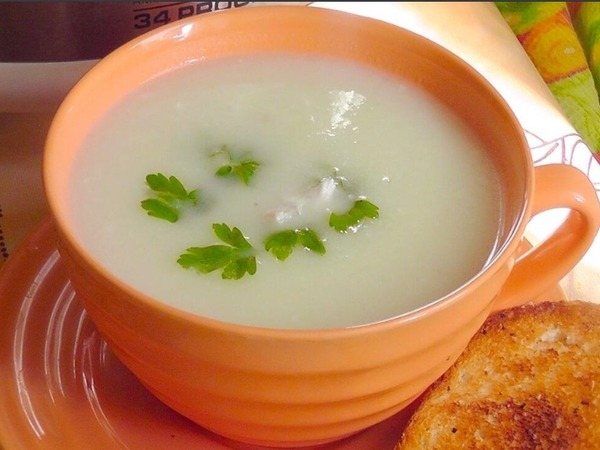
To prepare you will need:
- “Hercules” – 1 glass;
- 1 liter of water;
- 600 ml milk;
- 1 egg;
- Butter or vegetable oil – a teaspoon;
- 5 – 7 grams of sugar;
- Salt.
Sequencing:
Boil salted water, add Hercules, stirring. After boiling, place the pan on low heat and simmer the flakes for at least one hour. Then place on a sieve or cheesecloth and let the flakes drain well. Place the resulting liquid with a mucous consistency on the fire and let it boil. Cool slightly and add egg and milk dressing. To prepare the dressing, combine the beaten egg with milk. Add sugar and butter to the warm mixture and stir until completely dissolved.
The next soup that can be recommended during the period of subsiding of an exacerbation, as well as for erosive and hyperacid gastritis, is pureed.
Beneficial features
Rice is a natural source of nutrients:
- vitamins: groups B, K, PP, H, E;
- micro - and macroelements: boron, calcium, silicon, iodine, copper, iron, nickel, phosphorus, chlorine, zinc, potassium, fluorine, sulfur, etc.;
- amino acids, including essential ones: tryptophan, leucine, isoleucine;
- phospholipids: lecithin, which takes part in the restoration of damaged cells of the gastric mucosa;
- plant fibers and active bio-compounds.
Nutritional value of rice 100 g (average):
- calories 303 kcal;
- proteins 5 g;
- fats 6 g;
- sugar 62.3 g;
- vegetable fibers 9.7 g;
- water 14 g.
In addition to the nutritional value of rice, it is also useful as a healing product for inflamed stomach walls:
- when cooked, it has a mucous consistency and envelops the walls of the stomach, protecting it from the aggressive action of hydrochloric acid.
- it is easily digested by the stomach and is well absorbed in the gastrointestinal tract;
- Rice grains absorb various harmful substances from the stomach, which is very important for gastritis.
- it contains a lot of carbohydrates - a source of energy, which helps restore the body during illness.
- Rice dishes can be consumed in all age categories.
Can rice harm your stomach?
For rice (this mostly applies to the white variety), it is interesting that its beneficial properties, if consumed excessively, can harm the body. We are talking about the enveloping properties of rice. Due to these properties, constipation and kidney stones can develop. There is also a risk of developing vascular atherosclerosis.

Preparing a safe broth
To prepare broth that is allowed for any type of gastritis, follow the rules that we gave above. Use poultry, meat, or lean fish that has been previously filleted (without skin).
To ensure a high-quality broth, immerse the washed fillet only in cold water. The ratio of water and meat is approximately 3:1, that is, we take 300 grams of fillet, which means that 900 ml of water is required.
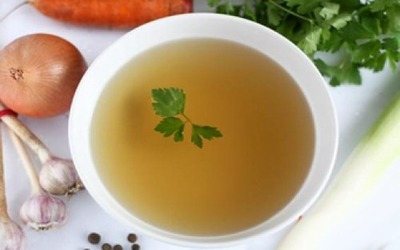
To cook the broth, take a saucepan with thick walls, which you cover with a lid before boiling. After the broth boils, skim off the foam and reduce the heat to low. If foam accumulates again, do not forget to remove it.
If your gastritis is in remission, you can add raw onion and parsley root to the pan when adding meat products - this will make the broth aromatic.
Now about time. Cook chicken broth for one hour; if you are preparing pork or beef broth, it will take 2.5 hours, no less.
Important! To make the broth low-fat, let it cool thoroughly after cooking. All fat accumulates on the surface in the form of a whitish film. Carefully remove the film from the broth and strain the remaining liquid.
Fish broth is ready after 40 minutes from the start of boiling, vegetable broth - after 30 minutes.
Broths, prepared correctly, are used not only for preparing first courses, but also as a basis for porridges, and also as an independent dish.
Prohibitions and dietary options for a sick stomach
The most stringent restrictions in the assortment of first courses are necessary for gastritis with high acidity, erosive and atrophic gastritis. The following are completely prohibited :
- all seasoning soups. Traditional borscht, sour and fresh cabbage soup, pickles, solyanka seasoned with fried onions and lard are strictly prohibited.
- Mushroom soups and dishes made from legumes are also prohibited - peas, beans, lentils - they are difficult and take a long time to digest, increase the acidity of the stomach and gas formation in the intestines.
We offer several recipes that are approved for erosive, atrophic and hyperacid gastritis.
Creamy vegetable soup
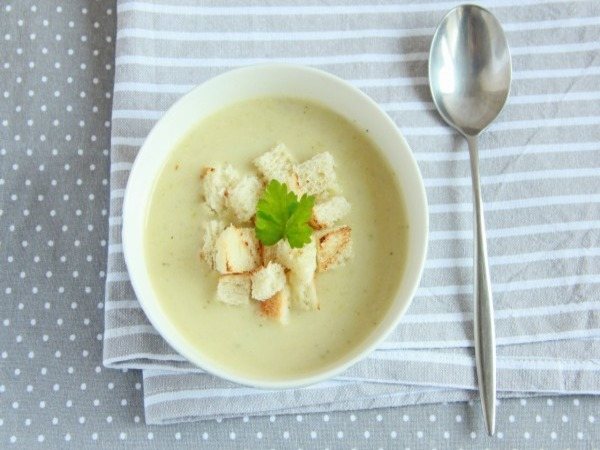
To prepare a vegetable first course, you can use any seasonal vegetables. We present a classic recipe that can be prepared at any time of the year.
You will need:
- Potatoes – 2 medium tubers;
- 1 small onion;
- broccoli – 200 grams;
- 1 medium carrot;
- Water – 3 glasses;
- Olive oil – 1 tablespoon;
- Salt - to taste.
Cooking technology:
Wash all the vegetables, peel them, cut them into small cubes and put them in boiling salted water. Boil until done. Puree the soup in a blender or through a sieve, bring to a boil again, add oil.
Chicken broth for high acidity
There are no special preparations for chicken broth; it is cooked according to the same “dietary principles” as for any other form of the disease. You should not overuse broths on the menu; pureed first courses are better filling and have enveloping properties.
Puree cereal soup
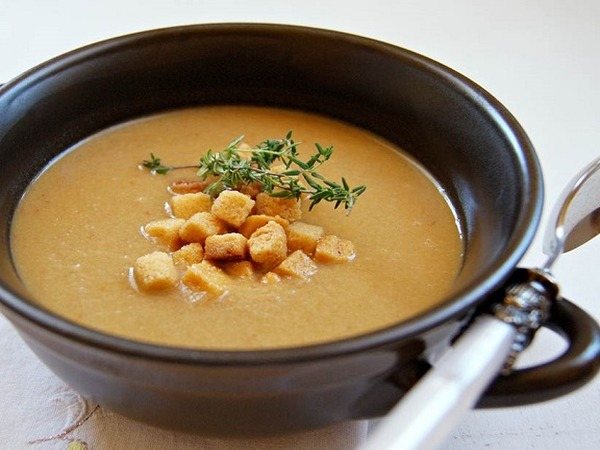
To prepare a cereal first course, you can use buckwheat, rice, and millet groats. For aggressive forms of gastritis, it is undesirable to use pearl barley, whole oatmeal and semolina. We offer a recipe based on buckwheat.
You will need:
- Buckwheat – 70 – 80 grams;
- Chicken broth (prepared in advance) – from 800 ml to 1 liter;
- Potatoes, carrots - 1 piece each;
- Butter or vegetable oil – 1 tablespoon;
- Salt.
Cooking technology:
We sort the buckwheat, rinse it, and boil it in half the chicken broth. In the other half of the broth, boil the chopped vegetables. Combine the parts and place in a blender. Grind and add broth to desired consistency. Add oil.
How to cook diet soup with tender meatballs
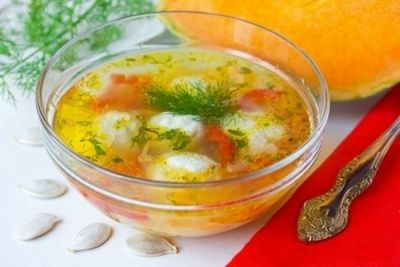
Soup with meatballs is an appetizing first course familiar from childhood. Compared to broth-based soup made from a whole piece of meat, it is light and cooks very quickly. The recipe does not require great culinary skills, especially if you use ready-made minced meat. You don’t want to give up such a simple and tasty soup, even if your health condition or desire to lose weight forces you to stick to a diet. But you shouldn’t cross out the recipe from your menu. An excellent solution is to prepare a diet soup with meatballs.
In this option, potatoes and rice are excluded from the ingredients, and lean meat is taken, for example, chicken or turkey breast, instead of traditional beef or pork. A dietary recipe for meatballs does not involve adding unnecessary products like semolina or starch. It is better to prepare minced meat at home so as not to negate all the benefits of the dish, because the composition and quality of a store-bought product is questionable. Fresh or frozen vegetables are added to the broth, this saves time on preparing frying that increases the fat content of the soup. Thus, an easy recipe includes natural, well-combined products - meat, vegetables, water.
- chicken or turkey breast – 500 g;
- carrots – 1 pc.;
- cauliflower or broccoli – 400 g;
- bell pepper – 1 large or 2 small;
- tomato – 1–2 pcs.;
- water – 1.5 l;
- greens – 50–100 g.
Cooking time: 1 hour.
Number of servings: 6.
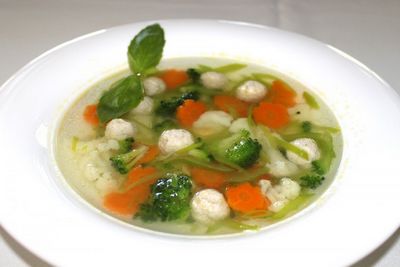
- Grind the poultry meat through a meat grinder. If you have time, it is better to do this twice, then the meatballs will taste more tender. Add salt. You should not add an egg; it can make the broth cloudy.
- Place water in a saucepan on the stove.
- At this time, clean and cut vegetables. Carrots can be cut into thin slices or small cubes. Wash cabbage (cauliflower or broccoli, take the one you like best, or a mixture of both types), and separate into inflorescences. Bell peppers are beautiful cut into short strips and cubes.
- Throw meatballs into boiling water. You can remove pieces of minced meat from a spoon, or you can pre-roll small balls. It is advisable to lower the meatballs one at a time so that they do not stick together in the soup. When the water boils, cook over low heat, stirring the broth and skimming off the resulting foam with a slotted spoon.
- After 15 minutes, add prepared cabbage to the broth with meatballs.
- After another 5 minutes – chopped bell pepper.
- As for the tomato or tomato paste, this is an additional component; you don’t have to put it in, or you can put it along with the pepper. Some people like the clarity that traditional meatball soup has, while others prefer a recipe with a mouth-watering tomato-tinged broth. The dish can be different, you need to focus, first of all, on your taste preferences.
- Salt the soup. Turn off after 10 minutes, adding the greens a few minutes before they are ready.
Borscht with high acidity – is it allowed or not?
The traditional first course with fried potatoes, tomatoes, paprika and garlic is strictly prohibited in aggressive forms of the disease. If you prepare the first course according to a dietary recipe, you can treat yourself to a plate of aromatic borscht. Naturally, the taste will be very different, but still!
Here are some tips on how to prepare borscht for a patient with erosive or hyperacid gastritis.
- If you cook borscht with meat broth, be sure to drain the first water when cooking the meat.
- Replace white cabbage with Chinese or cauliflower.
- Before adding beets and carrots for frying, simmer in water without adding oil.
- Do not add tomatoes or tomato paste. Instead of sour cream for dressing, use low-fat yogurt.
What is included in borscht?
In its classic form, this dish consists of the following components:
- beet;
- beans;
- carrot;
- potato;
- cabbage;
- onion;
- tomato;
- fat: vegetable oil or piece of meat.
Separately, subject to proper preparation, all these products can be eaten by patients with gastritis. But in borscht the ingredients begin to interact with each other. Vegetables give up the extractive (secretion-stimulating) substances they contain to boiling water, resulting in a broth. If the dish is not vegetarian, then the meat provides additional fat. At the end, each housewife adds spices at her own discretion, and the food acquires new taste qualities and increases its extractive abilities.
First courses with normal and low acidity
For patients with normal and low acidity, the culinary horizons are somewhat wider - first courses can be acidified with lemon juice in small quantities; fresh tomatoes, sweet peppers, and white cabbage can be used to prepare aromatic cabbage soup or borscht.
The principles of preparing first courses remain unchanged, that is, frying and sautéing are excluded.
The following are considered prohibited:
- Bean soups.
- Mushroom soups.
- Spicy soups.
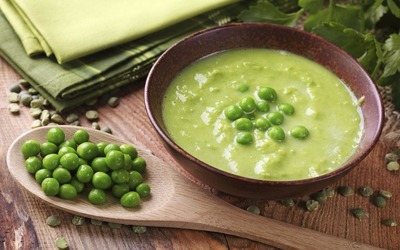
But such a dish is the exception rather than the rule. There is a strict prohibition regarding any mushrooms for gastritis, even with normal acidity. But if the mushroom aroma still seduces you, you can try the first dish in a weak mushroom broth, provided that you remove the mushrooms themselves from there.
We believe that it is not worth deceiving the body in this way - heavy food is ready to provoke an exacerbation at any moment. And it’s definitely of no use to you. Among the huge range of dietary recipes, you can choose an equivalent replacement. For example, make soup with meatballs from lean meat, which has no contraindications, or pumpkin and cheese soup.
The secret of experienced patients: If at the end of cooking you add a little tofu cheese or low-fat rennet cheese to any first course, your soup will acquire a very unique and piquant aroma. The additive is allowed for pureed and traditional dishes, and for broths. Give it a try.
Pumpkin soup
It turns out very beautiful and tasty. Making this soup is not difficult. Pumpkin can generally be stored at home for a very long time, which makes this vegetable available at almost any time of the year.
Products:
- water – 2 liters;
- pumpkin – 0.3 kilograms;
- wheat flour - tablespoon;
- butter.
The peeled pumpkin is cut into cubes and stewed in a small amount of water. The finished vegetable is chopped. Next, they do the dressing - flour and butter are fried in a frying pan until golden brown and diluted with broth. All ingredients are mixed with water and put on fire. After boiling, turn off the soup. Season with sour cream or yogurt.
Requirements for the menu for gastritis of the stomach
To eliminate the pathology, you will need complex therapy and a properly formulated diet. During the acute period, they refuse their favorite borscht, mushroom soup; if you have gastritis, you should not eat kharcho, rassolnik or cabbage soup. It is necessary to take care of damaged mucous membranes. Properly prepared soups will help the affected organ digest food:
- Dietary soups recommended for gastritis have a gentle effect.
- The broth in their base should not be concentrated.
- It is allowed to add various cereals, a little milk, potatoes, and a piece of butter.
- It is important to grind all the ingredients; you can also cook soup with meatballs for gastritis.
You should adhere to the following dietary rules:
- Prevent mechanical impact on the affected organ. Do not include coarse dietary fiber in your diet. It is better to eat vegetables boiled or baked. We only cook porridges that are very boiled. Food with a semi-homogeneous consistency is digested more quickly.
- The exclusion of herbs and spices prevents irritation.
- All food should only be warm.
Is it possible to have ear with gastritis with low acidity?
The diet that is prescribed for gastritis with a low level of acidity is under No. 2. It is aimed at stimulating secretory function and preventing damage to the mucous membrane. Therefore, the menu includes fish soup and vegetable broths.
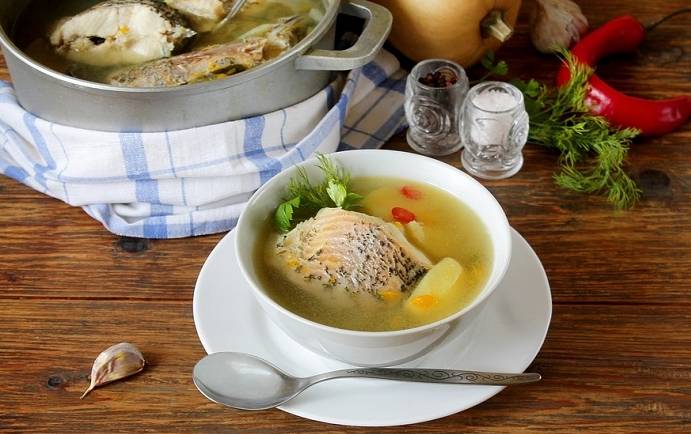
This dish will enrich the body with substances such as calcium, phosphorus, and amino acids. It contains collagen, which restores the gastric mucosa and has an enveloping effect. The gastroenterologist recommends cooking trout fish soup. It contains polyunsaturated acids that contribute to the normal functioning of the organ.
Cooking principles
The main thing is to make the broth weak. Fatty types of meat, spices, canned food, and all kinds of smoked foods are prohibited. Do not add cabbage, radishes or legumes. Eating these foods causes bloating. Avoid eating very hot or too cold food.
Soup recipes for gastritis may contain chicken breast fillet, turkey meat, rabbit or veal.
It is better not to eat milk soups, which are allowed for this disease, in the morning. Slime soups are very healthy and nutritious. They have an enveloping effect and relieve the inflammatory reaction. In the process of preparing fish soup for gastritis, exclusively low-fat varieties of fish are used. Should you eat chicken soup? Such a dish is very appropriate for this pathology.
Cooking rules
Boiled dishes are an important component of the diet of people with diseases of the digestive system. Liquid food carefully envelops the affected walls of the stomach, so soup for gastritis can and should be made part of the daily diet:
- All ingredients are cut very finely, sometimes turned into puree.
- Vegetables cannot be overcooked.
- You can diversify your diet with pumpkin, zucchini, and broccoli.
- Sautéed flour is added to form the consistency.
- Spices and mushrooms are excluded.
- Instead of butter, it is better to use vegetable oil.
- It is allowed to use rice and rolled oats.
Making the right soups
In order not to burden the digestive system, it is recommended to avoid using strong, rich broth. Vegetable broth is better suited for cooking.
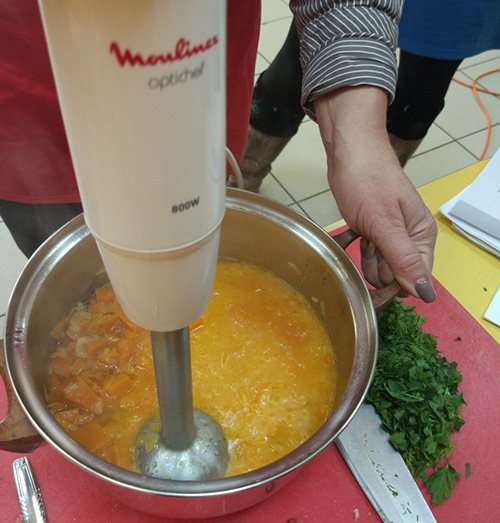
The components should be well ground: this will prevent injury to the stomach walls by large, solid ingredients and will make the dish easier to digest. It is better to grind the finished dish to a puree-like, liquid consistency. They require less hydrochloric acid to digest.
Aggressive substances should not be included in the composition. Spices, herbs, sauces, and high-fat components should not be added to the soup.
Which soup is better?
Depending on the course of the underlying disease, the patient is recommended to change his menu.
Exacerbation of gastritis
During an exacerbation and at the beginning of convalescence, you need to eat foods that do not stimulate secretion. These include:
- Dairy first courses containing vermicelli, pureed cereals (for example, buckwheat);
- Carrot, pumpkin, potato, squash puree soup and others;
- Broths based on chicken breast fillet or fresh veal.
Chronic course
At this stage, it is allowed to diversify the diet:
- Soups made from lean fish or meat;
- Vegetable first courses, for example, chicken broth.
What soups can you eat for gastritis?
Patients with stomach diseases are allowed chicken, vegetable, and milk soups; in case of gastritis, they do not create a load on the damaged organ. First courses are easy to digest when pureed. Buckwheat soup will be very useful. Mucous soups gently envelop the affected walls of the stomach and prevent the effects of hydrochloric acid. They are prepared as follows:
- Boil the cereal in a weak broth of meat or vegetables for an hour;
- The resulting mass should be filtered through cheesecloth;
- It is allowed to drive in a small raw yolk.
Sometimes the yolk is replaced with an egg-milk mixture.
Zucchini puree soup

Ingredients:
- zucchini - 2 pieces;
- potatoes -2 pieces;
- carrot – 1 piece;
- onion - 1 piece;
- salt - to taste.
Healthy soups for the stomach
Nutritionists recommend including weakly concentrated soups made from vegetables, meat, fruits, cereals and milk in the diet of a patient with stomach diseases.
Cream soup
Soups with a puree consistency bring the greatest benefit to the stomach. This dish envelops the gastric mucosa and thereby prevents hydrochloric acid from coming into contact with the gastric walls. Soups are prepared for patients with stomach diseases from vegetables and meat. They're fast
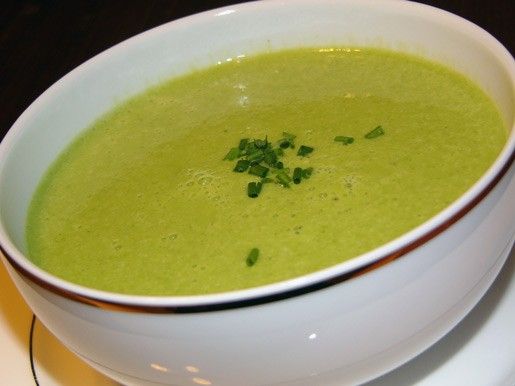
Puree soups are the most beneficial for the stomach
are absorbed and do not overload the digestive system.
To make the right puree soup, you must adhere to the following preparation recommendations:
- grind all the components that are in the dish;
- to make puree, you can use a masher, strainer or blender;
- in the process of cooking liquid soup, there is no need to overcook the vegetables, as this destroys the vitamins;
- to make the dish more viscous, add oatmeal to it;
- To give the soup a dense consistency, it is necessary to add toasted wheat flour or low-fat cream to it at the end of cooking.
The puree soup will be nutritious and at the same time dietary if you prepare it from meat broth according to the following recipe:
- boil 100 g of lean meat in 300 g of vegetable broth;
- add half a cup of rice;
- at the end of cooking, pour in 100 g of milk and one egg yolk;
- take out the meat and grind it using a blender or meat grinder;
- puree vegetables and rice or use a blender;
- Combine the puree ingredients and bring to a boil over heat, while stirring and skimming off the foam;
- when the dish has cooled a little, you can add a teaspoon of butter to it.
To prepare a vegetable first course, vegetables are selected that are allowed for stomach diseases. Pumpkin is rich in vitamins and microelements. It should be peeled, cut into cubes and stewed in vegetable broth until tender. You need to rub the finished pumpkin through a sieve or grind it to a puree-like consistency using a blender. Combine pumpkin puree with vegetable broth, bring to a boil and season with white sauce. Stir the vegetable puree and bring it to 100 degrees Celsius again.
To make a white sauce for seasoning soup, you need to dry the flour in a frying pan until it turns yellowish, dilute it with vegetable broth and strain. At the end of cooking the vegetable puree soup, you can add sour cream. Using this technology, first courses are prepared with the addition of other vegetables.
Slimy soups
If your stomach hurts, doctors recommend diversifying your diet with mucous soups, as they envelop the gastric mucosa and do not injure it. To prepare such a dish, you should take 50 g of rice cereal, carrots, previously cooked broth from lean meat, onion, parsley and salt. Chop the vegetables and add to the meat broth. Bring the ingredients to a boil, reduce heat and cook for another half hour.
Strain the finished broth through cheesecloth, add washed rice and cook until fully cooked. You should strain the broth again, add salt and stir. You can prepare slimy soup not only from rice, but also from other cereals that have a viscous consistency, for example, rolled oats.
Milk soup
To prepare milk soup, you must adhere to the following rules:
- milk must be diluted with water in a one to one ratio;
- You can use cereals (except barley and millet) for a dairy first course.
Recipe for liquid milk soup with buckwheat:
- rinse and sort the buckwheat, cook it until half cooked;
- add half a liter of boiled milk to the porridge, add salt and sugar;
- At the end of cooking, add a teaspoon of butter.
Delicious dairy first course with apples. To prepare it, you need to peel the apples and cut them into small cubes. Stew chopped apples in water with sugar. Next, you need to grind the egg yolks with sugar, add starch and milk. Add boiling milk to the resulting consistency, strain, cool and mix with apples.
Fruit soup
To prepare liquid fruit soup, you need to boil 2 tablespoons of rice in a liter of water, and at the same time prepare 100 g of dried fruits, freshly squeezed juice from one orange, 200 g of fruit and 50 g of sugar. Fruits need to be washed, peeled, cut and filled with water. Bring the fruit and water to a boil, reduce heat and simmer for another 15 minutes. The finished products are taken out, the resulting compote is sweetened, orange juice is added and rice is added. Boil the soup until the rice is ready, then cool and pour into plates.
New potato soup with dill
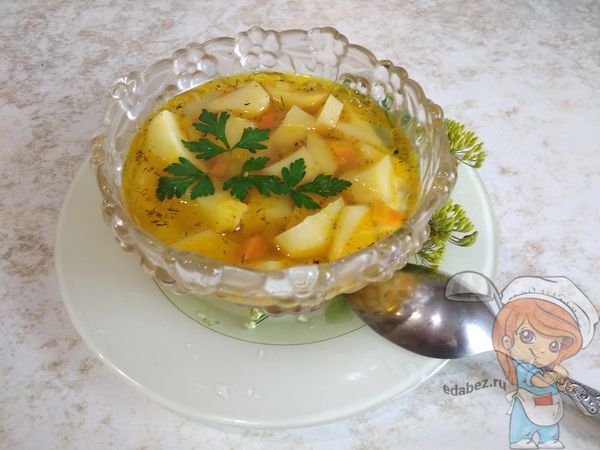
Ingredients:
- potatoes – 350 g;
- water – 0.8 l;
- carrot – 1 piece;
- onion - 1 piece;
- dill seeds - 1 tbsp. l;
- greens, vegetable oil - to taste.
Wash, peel and cut young potatoes into small pieces. Pour water into the pan, add salt and add potatoes.
While waiting for the liquid to boil, prepare the carrots and potatoes - finely chop them and sauté in sunflower oil in a frying pan. Combine vegetables with potatoes and cook until tender. Pour in dill grains and herbs and let it brew.
Cauliflower puree with added zucchini

Ingredients:
- cauliflower – half a kilo;
- zucchini - half a kilo;
- carrots – 100g;
- onion – 100g;
- vegetable oil, salt, herbs - to taste.
How to make soup tasty and healthy
Simple tricks will help with this:
- It's worth buying a blender. The device will ensure a homogeneous consistency of the prepared dishes.
- It is good to boil vegetables in meat or fish broth.
- To increase calorie content, you can add a little rice or millet.
- Avoid the use of refills.
- Hercules flakes increase the viscosity of the food.
In general, eating according to the rules and tasty is not difficult. You just need to show your imagination.
Beneficial properties of borscht
The dish is not only tasty, it also contains a lot of useful substances. Borscht provides a person with:
- vitamins B, E, A, C and K;
- easily digestible fiber;
- iodine and magnesium.
Helps the body get rid of:
- Radionuclides.

Borsch enriches the body with iodine - Pesticides.
- Nitrates and heavy metals.
A healthy dish activates carbohydrate metabolism and protects against the appearance of:
- diabetes mellitus;
- liver diseases.
Vitamin K protects against such ailments.

The dish contains vitamin K
